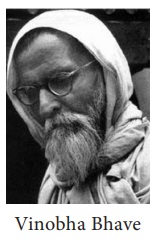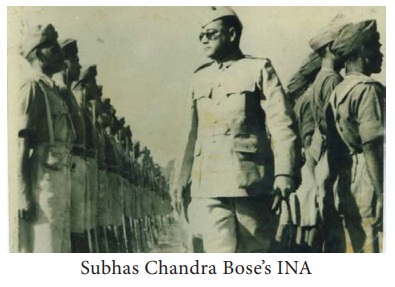India Nationalism: Gandhian Phase - Developments leading to Quit India Movement | 10th Social Science : History : Chapter 8 : Nationalism: Gandhian Phase
Chapter: 10th Social Science : History : Chapter 8 : Nationalism: Gandhian Phase
Developments leading to Quit India Movement
Developments leading to Quit
India Movement
(a) Individual Satyagraha
In August
1940 Viceroy Linlithgow made an offer in return for CongressŌĆÖ support for the
war effort. Hence Gandhi declared limited satyagraha which would be offered by
a few individuals. Vinobha Bhave was the first to offer satyagraha on 17
October 1940.

The
satyagraha continued till the end of the year. During this period more than 25,000
people were arrested.
(b) Cripps Mission
On 22
March 1942, the British government sent a mission under Cabinet Minister Sir
Strafford Cripps. The negotiations between the Cripps Mission and the Congress
failed as Britain was not willing to transfer effective power immediately. The
Cripps Mission offered:
1. Grant of Dominion Status after the War
2. Indian Princes could sign a separate agreement
with the British implying the acceptance for the demand of Pakistan.
3. British control of defence during the War.
Both the
Congress and the Muslim League rejected the proposal. Gandhi called the
proposals as a post-dated cheque on a crashing bank.
(c) "Do or Die" Call by Gandhi
The
outcome of the Cripps Mission caused considerable disappointment. Popular discontent
was intensified by war time shortages and steep rise in prices. The All India
Congress Committee that met at Bombay on 8 August 1942 passed the famous Quit
India Resolution demanding an immediate end to British rule in India. Gandhi
gave a call to do or die. Gandhi said, ŌĆśWe shall either free India or die in
the attempt; we shall not live to see the perpetuation of our slavery.ŌĆØ A
non-violent mass struggle under Gandhi was to be launched. But early next
morning on 9 August 1942 Gandhi and the entire Congress leadership was
arrested.
(d) Role of Socialists
With
Gandhi and other prominent leaders of the Congress in jail, the Socialists
provided the leadership for the movement. Jayaprakash Narayan and Ramanand
Misra escaped from prison and organised an underground movement. Women
activists like Aruna Asaf Ali played a heroic role. Usha Mehta established
Congress Radio underground which successfully functioned till November 1942.

(e) PeopleŌĆÖs Response
As news
spread to different parts of India, a spontaneous protest broke out everywhere.
The people protested in whatever form that they could, such as hartals,
strikes, picketing. The government suppressed it with brute force. People
attacked government buildings, railway stations, telephone and telegraph lines
and all that stood as symbols of British authority. This was particularly
widespread in Madras. Parallel governments were established in Satara, Orissa,
Bihar, United Provinces and Bengal.
(f) Subhas Chandra Bose and INA
Subhas
Chandra Bose who had left the Congress was now under house arrest. He wanted to
strike British hard by joining its enemies. In March 1941, he made a dramatic
escape from his house in disguise and reached Afghanistan. Initially he wanted
to get the support of Soviet Union. After the Soviet Union joined the Allied
Powers which included Great Britain, he went to Germany. In February 1943, he
made his way to Japan on a submarine and took control of the Indian National
Army. The Indian National Army Captain Lakshmi Sahgal headed it (Azad Hind
Fauj) had earlier been organized by Gen. Mohan Singh with Indian prisoners of
war with the support of Japanese in Malaya and Burma. Bose reorganised it into
three brigades: Gandhi Brigade, Nehru Brigade and a womenŌĆÖs brigade named after
Rani of Jhansi. Subhas Chandra Bose formed the Provisional Government of Free
India in Singapore. He gave the slogan ŌĆśDilli ChaloŌĆÖ. INA was deployed as part
of the Japanese forces. However, the defeat of Japan stopped the advance of
INA. The airplane carrying Subhas Chandra Bose crashed bringing to an end his
crusade for freedom.

The
British government arrested the INA officers and put them on trial in the Red
Fort. The trial became a platform for nationalist propaganda. The Congress set
up a defence committee comprising Nehru, Tej Bahadur Sapru, Bhulabhai Desai and
Asaf Ali. Though the INA officers were convicted they were released due to
public pressure. The INA exploits and the subsequent trials inspired the
Indians.
Related Topics